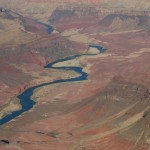US National Park Grand Canyon
In the north-west of the state of Arizona there’s one of the most interesting and unique corners of the Earth – U.S. national park Grand Canyon occupying square of about 5 thousand square meters (8.5 sq. feet). The park was founded in 1908 for protection of a unique natural formation – the canyon of the Colorado River which is located in its middle course. This huge and the most grandiose canyon on the Earth is 277 miles (446 km) long, up to 18 miles (29 km) wide and attains a depth of over a mile (1.83 km) (6000 feet). Downstairs the walls gradually get closer together, and on the bottom the canyon is only about 100 meters (328 feet) long.
The Canyon was formed for around 10 million years: the plain on which the Colorado River was flowing was uplifted by underground powers, while the water flow gradually cut through the plateau washing away pretty soft layers of the canyon – limestone, sandstone and shale. Nowadays the oldest layer already came out to the surface – granite, destruction of which happens much slower. The red-brown waters of Colorado (the very name of the river is translated from Spanish as “red”) are rushing at a speed of 20 km (12.5 ml) per hour below rolling on the bottom huge boulders and pebble and carrying with itself so much sand and loam that the river becomes absolutely not transparent. The Colorado River carries approximately half a million tons of rocks every 24 hours. The rocks and sand carried by the river increase the destroying effect of Colorado, and it rubs by this “emery” every year a hole quarter of a millimeter (39.370×10−3 inches) deep even in the hardest granites of the Canyon’s bed.
The vast space of the Canyon does not look merely as a long narrow hole in the ground. It is filled with disorderly accumulations of residual mountains of the oddest shape. Backslides, water and wind erosion created in the Canyon contours of gigantic pagodas, pyramids, towers, fortress walls that are a unique sight in their simplicity and grandeur. Many of them have their own names: Vishnu’s Temple, Shiva’s Temple, Wodan’s throne etc.

